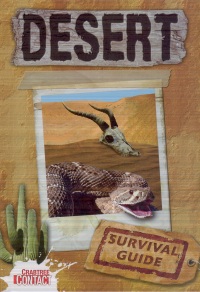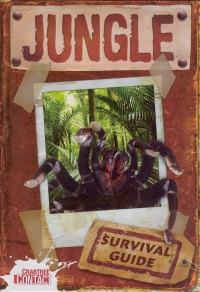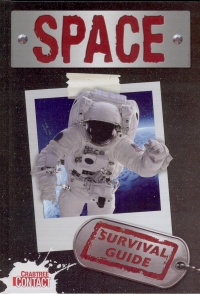| ________________
CM . . .
. Volume XVII Number 36. . . .May 20, 2011 
 |
Desert Survival Guide. (Crabtree Contact).
Ruth Owen.
St. Catharines, ON: Crabtree, 2010.
32 pp., pbk. & hc., $10.95 (pbk.), $20.76 (RLB.).
ISBN 978-0-7787-7554-6 (pbk.), ISBN 978-0-7787-7532-4 (RLB.).
Subject Heading:
Desert survival-Juvenile literature.
Grades 2-5 / Ages 7-10.
Review by Dave Jenkinson.
** /4
|
| |
|
 |
Jungle Survival Guide. (Crabtree Contact).
Ruth Owen.
St. Catharines, ON: Crabtree, 2010.
32 pp., pbk. & hc., $10.95 (pbk.), $20.76 (RLB.).
ISBN 978-0-7787-7555-3 (pbk.), ISBN 978-0-7787-7533-1 (RLB.).
Subject Heading:
Jungle survival-Juvenile literature.
Grades 2-5 / Ages 7-10.
Review by Dave Jenkinson.
** /4
|
| |
|
 |
Space Survival Guide. (Crabtree Contact).
Ruth Owen.
St. Catharines, ON: Crabtree, 2010.
32 pp., pbk. & hc., $10.95 (pbk.), $20.76 (RLB.).
ISBN 978-0-7787-7553-9 (pbk.), ISBN 978-0-7787-7531-7 (RLB.).
Subject Headings:
Life support systems (Space environment)-Juvenile literature.
Space flight-Physiological effect-Juvenile literature.
Space suits-Juvenile literature.
Grades 2-5 / Ages 7-10.
Review by Dave Jenkinson.
** /4
|
| |
|

excerpt:
SHELTER
If you do not already have a shelter, you will need to find or build one. In a desert, the daytime temperature can reach 140°F (60°C).
Look around you. Caves, trees, and large bushes can provide shelter. The shelter will give you shade. This will keep you cool during the day. It will help your body to use less water. (From Desert Survival Guide.)
SHELTER
To stay alive, you must build a shelter. A shelter will protect you from the rain.
You will need to build a shelter. If you have no equipment, you must improvise. This means you must think of new ways to do things.
A metal belt buckle can become a knife.
A large rock can be used as a hammer. (From Jungle Survival Guide.)
SPACE SUITS FOR SURVIVAL
Sometimes you will have to leave the safety of your spacecraft. This is called a space walk or EVA (Extra-Vehicular Activity).
You will need to wear a space suit to protect yourself from the extreme environment in space.
A space suit is like a small spacecraft. The spacesuit has 14 different layers. (From Space Survival Guide.)
This trio of Crabtree “Survival Guides” offers three scenarios in which readers could, at some point in their lifetimes, potentially find themselves, with two being actual possibilities and the third, space, being much more unlikely. Desert Survival Guide and Jungle Survival Guide are quite similar in their organizational structure, with each having eight chapters. In the former, the reader is asked to imagine being an occupant of a car that has broken down in a desert while the latter places the reader aboard an aircraft that has crashed in a jungle. In both situations, the books offer the readers suggestions on how to locate or create the three basics of survival: water, shelter and food. Water is obviously much more difficult to find in the desert than it is in a jungle, and the prevalence of rain in the jungle actually complicates finding or creating shelter and building and maintaining a fire. Both books deal with finding food as well as protecting oneself from the animal and insect dangers unique to their geographic settings. Whereas the open desert facilitates building visual signals to assist would-be airborne rescuers, the jungle’s canopy calls for a different approach to signalling. Only Desert Survival Guide suggests some contents of a very basic survival kit (knife, compass, whistle, waterproof matches, flashlight and first-aid kit). The books’ slim texts are generously illustrated with captioned colour photos.
The six chapters of Space Survival Guide tend to focus on the equipment astronauts have to wear/use when they are not in the “protected” environment of their shuttles or the International Space Station and are “outside” conducting space walks. The book’s factual contents are reinforced with captioned colour photos and labelled diagrams.
All three survival guides have a single page glossary, entitled “Need-To-Know Words,” that defines terms bolded in the text, a brief webography, and a one-page index.
The books’ brevity precludes their use as major information tools, but that same brevity, coupled with the book’s numerous illustrations, may make them attractive to beginning or reluctant readers.
Recommended.
Dave Jenkinson, CM’s editor, survives in the wilds of Winnipeg, MB.

To comment
on this title or this review, send mail to cm@umanitoba.ca.
Copyright © the Manitoba Library Association. Reproduction for personal
use is permitted only if this copyright notice is maintained. Any
other reproduction is prohibited without permission.
NEXT REVIEW |
TABLE OF CONTENTS FOR THIS ISSUE
- May 20, 2011.
AUTHORS |
TITLES |
MEDIA REVIEWS |
PROFILES |
BACK ISSUES |
SEARCH |
CMARCHIVE |
HOME |


